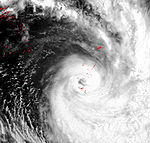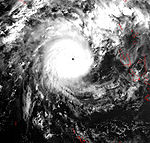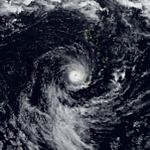1998–99 South Pacific cyclone season
| 1998–99 South Pacific cyclone season |

Season summary map
|
| Seasonal boundaries |
| First system formed |
December 4, 1998 |
| Last system dissipated |
May 26, 1999 |
| Strongest storm |
|
| Name |
Dani |
| • Maximum winds |
175 km/h (110 mph)
(10-minute sustained) |
| • Lowest pressure |
930 hPa (mbar) |
| Seasonal statistics |
| Total disturbances |
27 (record high)
|
| Total depressions |
14 |
| Tropical cyclones |
8 |
| Severe tropical cyclones |
4 |
| Total fatalities |
Unknown |
| Total damage |
Unknown |
| Related articles |
|
|
South Pacific tropical cyclone seasons
1996–97, 1997–98, 1998–99, 1999–00, 2000–01
|
| Tropical depression (Australian scale) |
| Tropical storm (SSHWS) |
|
|
| Duration |
December 14 – December 17 |
| Peak intensity |
75 km/h (45 mph) (10-min) 999 hPa (mbar) |
| Tropical depression (Australian scale) |
| Tropical storm (SSHWS) |
|
|
| Duration |
December 21 – December 24 |
| Peak intensity |
65 km/h (40 mph) (10-min) 997 hPa (mbar) |
| Category 3 severe tropical cyclone (Australian scale) |
| Category 2 tropical cyclone (SSHWS) |
|
|
| Duration |
December 23 – December 28 |
| Peak intensity |
140 km/h (85 mph) (10-min) 960 hPa (mbar) |
| Category 4 severe tropical cyclone (Australian scale) |
| Category 4 tropical cyclone (SSHWS) |
|
|
| Duration |
January 15 – January 22 |
| Peak intensity |
185 km/h (115 mph) (10-min) 925 hPa (mbar) |
| Category 2 tropical cyclone (Australian scale) |
| Tropical storm (SSHWS) |
|
|
| Duration |
January 22 – January 23 |
| Peak intensity |
100 km/h (65 mph) (10-min) 985 hPa (mbar) |
| Category 2 tropical cyclone (Australian scale) |
| Tropical storm (SSHWS) |
|
|
| Duration |
January 23 – January 26 |
| Peak intensity |
100 km/h (65 mph) (10-min) 985 hPa (mbar) |
| Category 1 tropical cyclone (Australian scale) |
| Tropical storm (SSHWS) |
|
|
| Duration |
February 9 – February 13 |
| Peak intensity |
85 km/h (50 mph) (10-min) 985 hPa (mbar) |
| Category 3 severe tropical cyclone (Australian scale) |
| Category 2 tropical cyclone (SSHWS) |
|
|
| Duration |
February 16 – February 21 |
| Peak intensity |
150 km/h (90 mph) (10-min) 955 hPa (mbar) |
| Tropical depression (Australian scale) |
|
|
| Duration |
February 17 – February 19 |
| Peak intensity |
75 km/h (45 mph) (10-min) 995 hPa (mbar) |
The 1998–99 South Pacific cyclone season was a near average South Pacific tropical cyclone season, with 8 tropical cyclones occurring within the South Pacific Ocean basin between 160°E and 120°W. Despite the season starting on November 1, the first tropical system of the season did not form until December 1, while the final disturbance of the season dissipated on May 27, 1999. During the season the most intense tropical cyclone was Severe Tropical Cyclone Cora, which had a minimum pressure of 930 hPa (27.46 inHg). After the season had ended the names Cora and Dani were retired from the naming lists, after they had caused significant impacts to South Pacific islands.
During the season, tropical cyclones were officially monitored by the Regional Specialized Meteorological Center (RSMC) in Nadi, Fiji and the Tropical Cyclone Warning Center in Wellington, New Zealand. While the United States Navy also monitored the basin and issued unofficial warnings throughout the season, through its Joint Typhoon Warning Center (JTWC) and Naval Pacific Meteorology and Oceanography Center (NPMOC). Tropical cyclones that were located between 160°E and 120°W as well as the Equator and 25°S were monitored by TCWC Nadi while any that were located to the south of 25°S between 160°E and 120°W were monitored by TCWC Wellington. During the season the JTWC issued warnings on any tropical cyclone that was located between 160°E and the 180° while the NPMOC issued warnings for tropical cyclones forming between 180° and the American coast. RSMC Nadi and TCWC Wellington both used the Australian tropical cyclone intensity scale, and measured windspeeds over a 10-minute period, while the JTWC and the NPMOC measured sustained windspeeds over a 1-minute period. For the first time this season, RSMC Nadi assigned a number and the letter F to each significant tropical disturbance that moved within the South Pacific basin, while the JTWC and NPMOC continued to assign a number and the letter P to significant tropical cyclones throughout the Southern Hemisphere.
...
Wikipedia















